Early years (1779–1810)
Antonia Nava de Catalán was born in Tixtla on 17 November 1779. Her parents were Nicolás Nava and María Celestina. She married Nicolás Catalán, the oldest son of Nicolasa Catalán, born in Chilpancingo in 1772. They had five sons, Nicolás, Manuel, Antonio, Pedro and one whose name is unknown, and three daughters, Teresa, María and Margarita. After their marriage, they moved from Tixtla to Chilpancingo, where they settled for a short time, until Nicolás Catalán had an argument with his father, and then moved to Jaleaca. The family was living in Jaleaca when the war of independence broke out in September 1810. The war of independence put their marriage to the test until they found General José María Morelos, who gave them security as to what would be the outcomes of the war.

Guerrero, officially the Free and Sovereign State of Guerrero, is one of the 32 states that compose the 32 Federal Entities of Mexico. It is divided into 81 municipalities. The state has a population of about 3.5 million people. It is located in southwest Mexico and is bordered by the states of Michoacán to the north and west, the State of Mexico and Morelos to the north, Puebla to the northeast and Oaxaca to the east. In addition to the capital city, Chilpancingo and the largest city Acapulco, other cities in Guerrero include Petatlán, Ciudad Altamirano, Taxco, Iguala, Ixtapa, and Zihuatanejo. Today, it is home to a number of indigenous communities, including the Nahuas, Mixtecs, Tlapanecs, Amuzgos, and formerly Cuitlatecs. It is also home to communities of Afro-Mexicans in the Costa Chica region.

Chilpancingo de los Bravo is the capital and second-largest city of the Mexican state of Guerrero. In 2010 it had a population of 187,251 people. The municipality has an area of 2,338.4 km2 (902.9 sq mi) in the south-central part of the state, situated in the Sierra Madre del Sur mountains, on the bank of the Huacapa River. The city is on Federal Highway 95, which connects Acapulco to Mexico City. It is served by Chilpancingo National Airport, which is one of the five airports in the state.
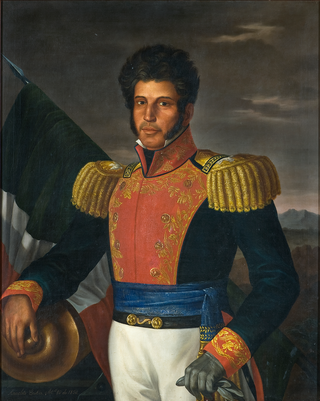
Vicente Ramón Guerrero Saldaña was a Mexican military officer, from 1810-1821and statesman who became the nation's second president in 1829. He was one of the leading generals who fought against Spain during the Mexican War of Independence.According to historian, Theodore G. Vincent, Vincente Guerrero lived alongside indigenous in Tlaltelulco and had the ability to speak Spanish and the languages of the Indigenous.
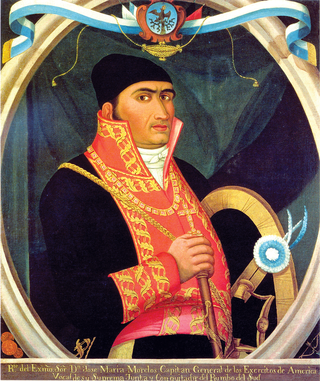
José María Teclo Morelos Pérez y Pavón was a Mexican Catholic priest, statesman and military leader who led the Mexican War of Independence movement, assuming its leadership after the execution of Miguel Hidalgo y Costilla in 1811.

The Mexican War of Independence was an armed conflict and political process resulting in Mexico's independence from the Spanish Empire. It was not a single, coherent event, but local and regional struggles that occurred within the same period, and can be considered a revolutionary civil war. It culminated with the drafting of the Declaration of Independence of the Mexican Empire in Mexico City on September 28, 1821, following the collapse of royal government and the military triumph of forces for independence.

Tixtla is a town and seat of the municipality of Tixtla de Guerrero in the Mexican state of Guerrero. The name is Nahuatl, and means either "maize dough" (masa) from textli; "our valley" from to ixtla; or "temple by the water" from teoixtlen'

Juan Nepomuceno Álvarez Hurtado de Luna, generally known as Juan Álvarez, was a general, long-time caudillo in southern Mexico, and president of Mexico for two months in 1855, following the liberals' ouster of Antonio López de Santa Anna. His presidency inaugurated the pivotal era of La Reforma.

Félix María Calleja del Rey y de la Gándara, primer conde de Calderón was a Spanish military officer and viceroy of New Spain from March 4, 1813, to September 20, 1816, during Mexico's War of Independence. For his service in New Spain, Calleja was awarded with the title Count of Calderon.
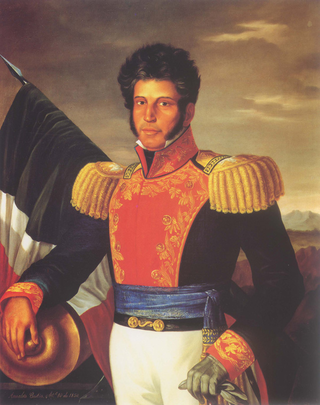
Afro-Mexicans played an important role in the Mexican War of Independence, most prominently with insurgent leader Vicente Guerrero, who became commander in chief of the insurgency. The initial movement for independence was led by the American-born Spaniard priest Miguel Hidalgo y Costilla in central Mexico. White Mexicans quickly abandoned the movement for independence which had become more of a social revolution, with Indians, Blacks, mixed-race castas, and other plebeians seeking social equality. The movement for independence remained active on the Gulf Coast and the Pacific Coast, where there were large concentrations of Afro-Mexicans. The royal army and the insurgent forces had reached a stalemate militarily, but the equation changed in 1820. American-born Spaniard and royalist officer Agustin de Iturbide sought an alliance with the insurgents led by Guerrero. Iturbide and the white creoles sought independence, but expected that racial hierarchies would continue in the post-independence period. Guerrero and other Afro-Mexicans demanded that they would be equal citizens and not until Iturbide acceded to that demand did the Afro-Mexican forces sign on to the Plan of Iguala which laid out the terms for the insurgency movement.
Chilpancingo de los Bravo is a municipality in the Mexican state of Guerrero. The municipal seat is Chilpancingo de los Bravo.

Coyuca de Catalán is a city and seat of the municipality of Coyuca de Catalán, in the state of Guerrero, southern Mexico.

The Constitution of Apatzingán, formally Decreto Constitucional para la Libertad de la América Mexicana, was promulgated on 22 October 1814 by the Congress of Anahuac gathered in the city of Apatzingán because of the persecution of the troops of Félix María Calleja. The constitution was valid for insurgent forces in the territories that it controlled during the Mexican War of Independence.

The Battle of El Veladero was a battle of the War of Mexican Independence that occurred from 1810 to 30 April 1811 at Cerro El Veladero, Acapulco de Juárez. The battle was fought between royalist forces loyal to the Spanish crown, commanded by Juan Antonio Fuentes, and Mexican rebels, commanded by José María Morelos and Rafael Valdovinos, fighting for independence from the Spanish Empire. The rebels won.
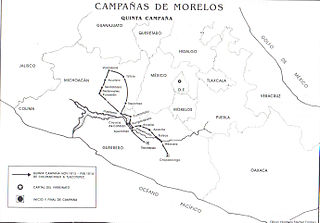
The Battle of Lomas de Santa María was a battle of the War of Mexican Independence that occurred from 23–24 December 1813 in the area around Lomas de Santa María, in the municipality of Valladolid. The battle was fought between the royalist forces loyal to the Spanish crown and the Mexican rebels fighting for independence from the Spanish Empire.
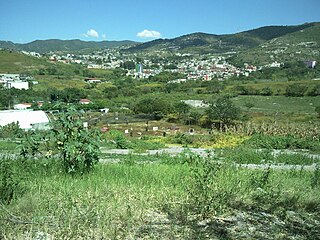
The Battle of Zitlala took place during the War of Mexican Independence on 4 July 1812 in the outskirts of Zitlala, Guerrero. The battle was fought between the royalist forces loyal to the Spanish crown, and the Mexican rebels fighting for independence from the Spanish Empire. The battle resulted in a victory for the Mexican rebels.

Leonardo Bravo was a Mexican liberal, landowner, and general. He was the brother of Máximo Bravo and father of Nicolás Bravo. Bravo participated with the insurgent faction during the development of the armed movement of the first stage of the Independence of Mexico.
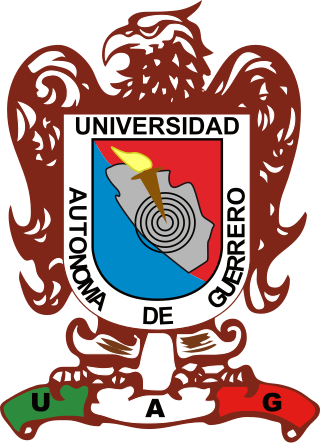
The Autonomous University of Guerrero is a public and autonomous institution of secondary education and higher education in the Mexican state of Guerrero. Its main campus is in Chilpancingo, with facilities in Acapulco, Taxco, Iguala, Tixtla, Ometepec, Tecpan de Galeana, Altamirano and other cities in the state.
Federal Highway 95D is a toll highway connecting Mexico City to Acapulco, Guerrero. Highway 95D is among the most important toll roads in the country, serving as a backbone for traffic out of Mexico City toward Morelos and tourist destinations in Guerrero.
Nicolás Catalán was a leader of the resistance stage of the Mexican War of Independence, active in the current state of Guerrero. He was married to Antonia Nava de Catalán.

















